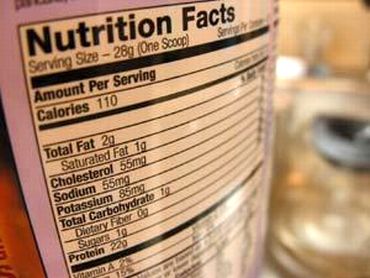 A little attention to detail can go a long way in boosting your health.
A little attention to detail can go a long way in boosting your health.
Health claims on food packages can be confusing and it's sometimes hard to reconcile the information on the front with what's on the nutrition facts panel at the back.
Making informed choices about the food you buy can help you maintain a healthy diet. Understanding food nutrition labels is essential to that process. Knowing your numbers for recommended daily calorie and nutrient intake can help you make choices to stay within healthy guidelines and to manage your weight.
Manufacturers have the option of providing additional information. But sometimes a little interpretation is required. For example what, exactly is 'low fat?' Here are the per-serving requirements that must be met before using these claims:
Fat-free: Less than 0.5 grams of fat, with no added fat or oil
Low fat: 3 grams or less of fat
Less fat: 25 percent or less fat than the comparison food
Saturated fat-free: Less than 0.5 grams of saturated fat and 0.5 grams of trans-fatty acids
Cholesterol-free: Less than 2 milligrams cholesterol and 2 grams or less saturated fat
Low cholesterol: 20 milligrams or less cholesterol and 2 grams or less saturated fat
Reduced calorie: At least 25 percent fewer calories than the comparison food
Low calorie: 40 calories or less
Extra lean: Less than 5 grams of fat, 2 grams of saturated fat, and 95 milligrams of cholesterol per (100 grams) serving of meat, poultry or seafood
Lean: Less than 10 grams of fat, 4.5 g of saturated fat and 95 milligrams of cholesterol per (100 grams) serving of meat, poultry or seafood
Light (fat): 50 percent or less of the fat than in the comparison food
Light (calories): 1/3 fewer calories than the comparison food
High-fibre: 5 grams or more fibre
Sugar-free: Less than 0.5 grams of sugar
Sodium-free or salt-free: Less than 5 milligrams of sodium
Low sodium: 140 milligrams or less
Very low sodium: 35 milligrams or less
Healthy: A food low in fat, saturated fat, cholesterol and sodium, that contains at least 10 percent of the Daily Values for Vitamin A, Vitamin C, iron, calcium, protein or fibre.
'High', 'Rich in' or 'Excellent Source': 20 percent or more of the Daily Value for the designated nutrient
'Good Source Of', 'More', or 'Added': The food provides 10 percent more of the Daily Value for a given nutrient than the comparison food
'Less', 'Fewer' or 'Reduced': At least 25 percent less of a given nutrient or calories than the comparison food
'Low', 'Little', 'Few', or 'Low Source of': An amount that would allow frequent consumption of the food without exceeding the Daily Value for the nutrient
When going through food labels...
Consider the following:
Serving Size/Servings Per Container: Serving sizes are standardised in measurements (cups etc) so you can compare similar foods. Numbers listed for calories and nutrient amounts are based on this 'serving size'. If you consume more than a serving then you must recognise that you are consuming additional calories and nutrients.
Calories: Calories are energy. The trick is to consume the right amount of calories and get the recommended number of nutrients at the same time.
% Daily Value: This tells you what percentage of daily nutrient requirements a food contains. Percentages of Daily Values (DV) are based on a 2,000 calorie-a-day diet. A DV greater than 20 percent of any vitamin or mineral indicates that a food is a good source of that nutrient.
Total Fat: Your fat intake throughout the course of the day should be about 30 percent of your total calories. The food label provides separate numbers for trans, monounsaturated, polyunsaturated, and saturated fats. Try to limit your intake of trans fats. The monounsaturated and polyunsaturated fats are healthier for your heart than the trans (although consumption of them should also be limited).
Sodium: To lessen your risk of hypertension, limit yourself to 1,500 milligrams of sodium per day.
Potassium: This mineral helps balance sodium levels in your blood. Although there is no 'Recommended Daily Allowance', experts agree that you need 2,000-3,500 milligrams daily.
Dietary Fibre: Fibre is the important key to managing your weight. Fibre helps you lose weight by making you feel full. Both soluble and insoluble fibres protect your arteries from cholesterol build-up and assist your digestive system. Look for foods high in fibre. You need 25 to 35 grams daily to stay healthy.
Sugars: Labels do not differentiate between natural and refined sugars, so look for added sugars in the ingredients list. High fructose corn syrup, cane syrup, brown rice syrup or evaporated cane juice are examples of refined sugars.
Protein: It is recommended that you have 0.8 grams of protein for every kilogram of body weight. So, divide your weight in pounds by 2.2 to get your weight in kilograms, then multiply that number by .8 to get the number of grams of protein needed each day. For example, if you weigh 135 pounds, or 61 kilograms, you will need about 49 grams of protein per day.
Vitamin A: The recommended daily allowance for Vitamin A is 900 micrograms per day. Vitamin A is an essential vitamin for maintaining healthy eyes and preventing infection.
Vitamin C: This is an essential nutrient with disease-fighting antioxidants. The recommended daily allowance is 75 milligrams. Manufacturers add it to all sorts of foods so be careful not to get too much. Excess Vitamin C may result in gastrointestinal problems.
At first, the need to be vigilant with food labels will be a hard lesson, but as time passes reading labels will become second nature. It will be well worth the investment and, in the end, your health will be better for it.






